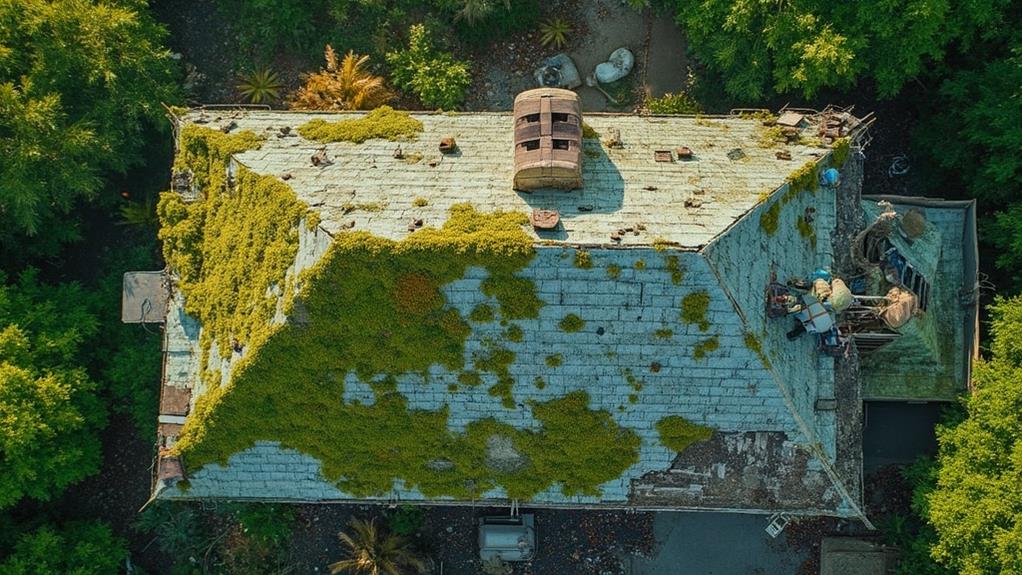Green solutions for repairing and reinforcing storm-damaged roofs offer eco-friendly alternatives to traditional methods. Recycled roofing materials, including rubber and plastic shingles, provide durability while reducing landfill waste. Plant-based sealants and adhesives offer comparable performance to conventional options with lower environmental impact. Solar tiles integrate energy generation into the roof structure, enhancing resilience. Cool roof technology reflects sunlight, improving energy efficiency and extending roof lifespan. Green insulation options, such as recycled denim and cellulose, provide excellent thermal performance. These sustainable approaches not only repair damage but also contribute to long-term environmental stewardship. Exploring these options can reveal additional benefits for homeowners and the planet.
Recycled Roofing Materials
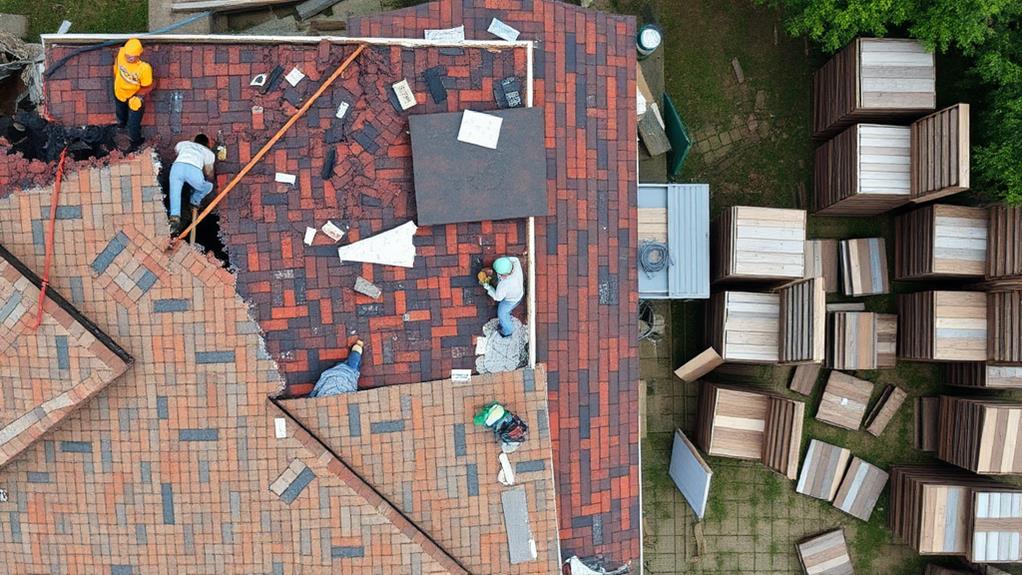
Shingles made from recycled materials offer an eco-friendly approach to repairing storm-damaged roofs. These innovative products utilize various recycled components, including plastic, rubber, and wood fibers, to create durable and sustainable roofing solutions.
Recycled rubber shingles, for instance, are manufactured from discarded tires, providing excellent resistance to impact and weather extremes. Similarly, plastic shingles made from recycled milk jugs and other post-consumer plastics offer superior longevity and UV resistance.
Another popular option is recycled metal roofing, which often incorporates reclaimed steel or aluminum. These materials not only reduce landfill waste but also reflect solar heat, improving energy efficiency.
Composite shingles blending recycled wood fibers with recycled plastic offer a more traditional aesthetic while maintaining eco-friendly credentials. Many of these recycled roofing materials come with extended warranties, matching or surpassing those of conventional products. Additionally, they often require less energy to produce than their non-recycled counterparts, further reducing their environmental impact.
Plant-Based Sealants and Adhesives
An emerging trend in eco-friendly roofing repair is the use of plant-based sealants and adhesives. These innovative products are derived from renewable resources such as soy, corn, and other vegetable oils, offering a sustainable alternative to petroleum-based options. Plant-based sealants and adhesives provide comparable performance to traditional products while reducing environmental impact and volatile organic compound (VOC) emissions.
These eco-friendly solutions offer excellent water resistance and durability, making them suitable for repairing and reinforcing storm-damaged roofs. They can effectively seal leaks, bond roofing materials, and protect against future water infiltration. Plant-based products are particularly effective for repairing asphalt shingles, metal roofing, and flat roof membranes.
In addition to their environmental benefits, plant-based sealants and adhesives are often safer for workers to handle and apply. They typically have lower odor levels and reduced health risks associated with prolonged exposure. As the roofing industry continues to prioritize sustainability, these bio-based alternatives are becoming increasingly available and cost-competitive. Homeowners and contractors seeking green solutions for storm-damaged roof repairs can confidently turn to plant-based sealants and adhesives as an effective and environmentally responsible choice.
Solar Tiles for Energy Generation
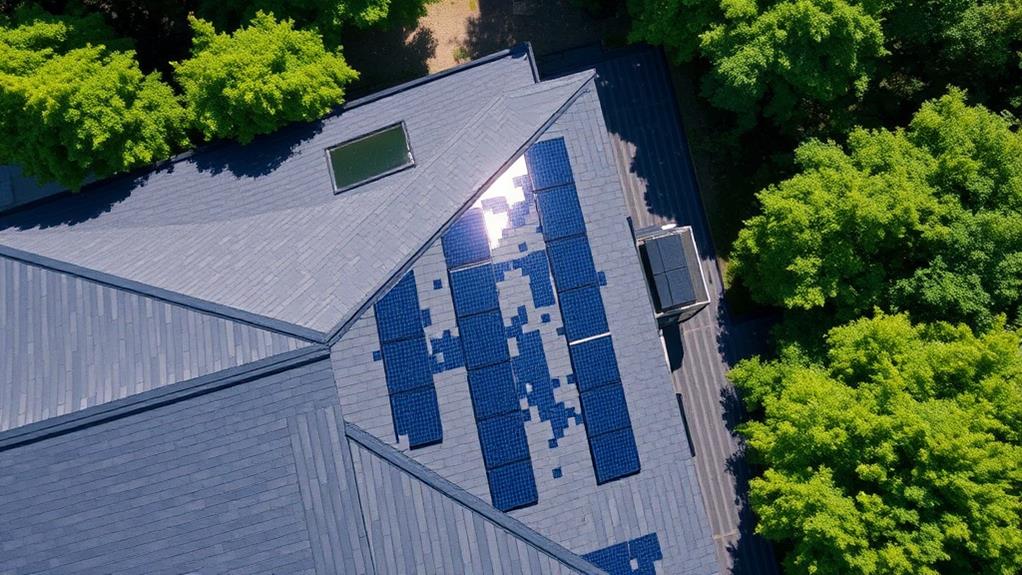
Innovative solar tiles offer a dual-purpose solution for repairing storm-damaged roofs while generating clean energy. These advanced roofing materials seamlessly integrate photovoltaic technology into durable, weather-resistant tiles that can replace damaged sections or cover entire roof surfaces. Solar tiles are designed to withstand harsh weather conditions, including high winds and hail, making them an excellent choice for storm-prone areas.
Unlike traditional solar panels, solar tiles blend in with existing roof aesthetics, maintaining the building's visual appeal. They come in various styles and colors to match different architectural designs. The tiles are typically made from tempered glass and feature high-efficiency solar cells that convert sunlight into electricity. This renewable energy source can significantly reduce a home's reliance on the power grid, lowering electricity bills and carbon footprint.
Installation of solar tiles during roof repairs or replacements can be more cost-effective than separate solar panel installations. Additionally, many regions offer incentives and tax credits for adopting solar technology, further offsetting the initial investment. As an eco-friendly roofing solution, solar tiles contribute to sustainable building practices while enhancing a property's resilience against future storm damage.
Cool Roof Technology
Cool roof technology represents another environmentally friendly approach to repairing and reinforcing storm-damaged roofs. This innovative solution involves applying highly reflective materials or coatings to the roof surface, which helps to reduce heat absorption and lower indoor temperatures. Cool roofs can be particularly beneficial in warm climates or urban areas prone to the heat island effect.
The primary materials used in cool roof technology include specialized reflective coatings, light-colored shingles, and reflective membranes. These materials are designed to reflect more sunlight and absorb less heat than traditional roofing materials. By implementing cool roof technology, homeowners can achieve significant energy savings, reduce cooling costs, and extend the lifespan of their roofing system.
In addition to energy efficiency benefits, cool roofs can help mitigate the impact of future storms by reducing thermal stress on the roofing materials. This increased durability can lead to fewer repairs and replacements over time. Furthermore, cool roofs contribute to improved indoor comfort, reduced greenhouse gas emissions, and decreased reliance on air conditioning systems. When considering green solutions for storm-damaged roofs, cool roof technology offers a practical and effective option for long-term sustainability and resilience.
Green Insulation Options
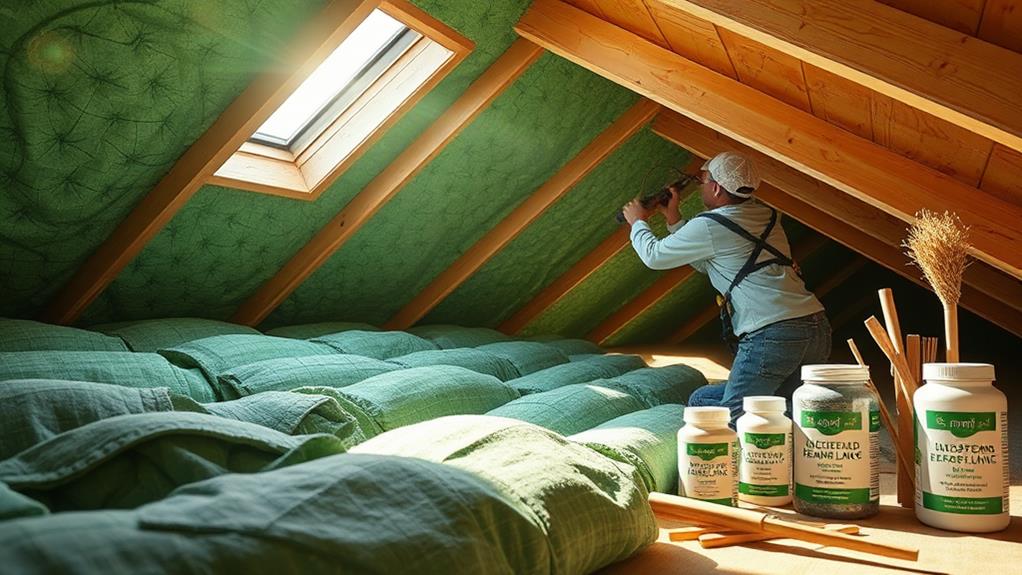
Several green insulation options offer environmentally friendly alternatives for repairing and reinforcing storm-damaged roofs. These materials not only provide excellent thermal performance but also contribute to reduced energy consumption and environmental impact.
Recycled denim insulation, made from post-consumer jeans, offers a sustainable solution with excellent sound-dampening properties. Cellulose insulation, composed of recycled paper products treated with fire retardants, provides effective thermal resistance and can be easily blown into attic spaces. Sheep's wool insulation, a renewable resource, naturally regulates humidity and offers fire-resistant properties.
For eco-conscious homeowners, spray foam insulation made from soy or castor oil provides an effective air barrier and moisture control. Cork insulation, harvested from the bark of cork oak trees, offers natural resistance to mold and pests while providing excellent thermal insulation.
hemp insulation, made from the plant's fibers, is biodegradable and offers good moisture management. Aerogel insulation, though more expensive, provides superior thermal performance with minimal thickness, making it ideal for space-constrained areas. These green insulation options not only repair and reinforce storm-damaged roofs but also contribute to a more sustainable and energy-efficient home.
Rainwater Harvesting Systems
Rainwater harvesting systems offer an eco-friendly solution for homeowners looking to repair and reinforce storm-damaged roofs while simultaneously conserving water resources. These systems collect and store rainwater from roof surfaces, reducing reliance on municipal water supplies and lowering utility costs. When integrated into roof repair projects, they can enhance the overall resilience of the structure.
Key components of a rainwater harvesting system include gutters, downspouts, filters, storage tanks, and pumps. During roof repairs, homeowners can install or upgrade these elements to maximize water collection efficiency. Durable, eco-friendly materials like recycled plastics or stainless steel can be used for gutters and downspouts, ensuring longevity and sustainability.
Incorporating a rainwater harvesting system during roof repairs offers multiple benefits. It reduces stormwater runoff, alleviating pressure on local drainage systems and minimizing erosion. The collected water can be used for irrigation, toilet flushing, and other non-potable purposes, significantly reducing household water consumption. Additionally, some municipalities offer incentives or rebates for installing these systems, making them an attractive option for environmentally conscious homeowners seeking to combine roof repairs with sustainable practices.
Air-Purifying Roof Coatings
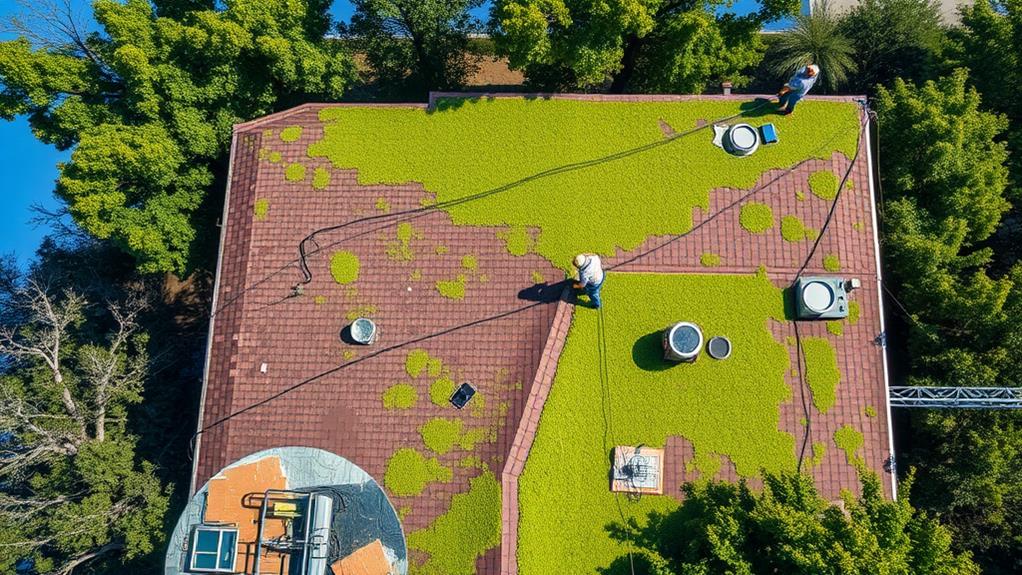
Beyond water conservation, innovative roofing solutions can also contribute to improved air quality. Air-purifying roof coatings represent a cutting-edge approach to combating air pollution while repairing and reinforcing storm-damaged roofs. These specialized coatings contain photocatalytic titanium dioxide, which reacts with sunlight to break down harmful air pollutants such as nitrogen oxides and volatile organic compounds.
When applied to roofing materials, these coatings create a self-cleaning surface that actively decomposes airborne pollutants, effectively turning the roof into a large-scale air purifier. The process is continuous and requires only sunlight to function, making it a sustainable and low-maintenance solution. In urban areas with high pollution levels, widespread adoption of air-purifying roof coatings could significantly improve local air quality.
Additionally, these coatings offer protective benefits for the roof itself. They can enhance the roof's resistance to UV radiation, reduce heat absorption, and extend the lifespan of roofing materials. This dual functionality makes air-purifying roof coatings an attractive option for homeowners and businesses looking to repair storm damage while simultaneously contributing to environmental improvement and long-term roof durability.
Frequently Asked Questions
How Long Do Eco-Friendly Roof Repairs Typically Last Compared to Traditional Methods?
Eco-friendly roof repairs typically last as long as traditional methods, often 15-20 years or more. Durability depends on factors like material quality, installation technique, and environmental conditions. Regular maintenance can extend the lifespan of both eco-friendly and traditional repairs.
Are Green Roofing Solutions More Expensive Than Conventional Repair Techniques?
As the old saying goes, "You get what you pay for." Initially, green roofing solutions may cost more than conventional techniques. However, their long-term energy savings, durability, and environmental benefits often justify the higher upfront investment.
Can Storm-Damaged Roofs Be Fully Repaired Using Only Sustainable Materials?
Storm-damaged roofs can often be repaired using sustainable materials, but the extent of damage and specific roof type may limit full reliance on eco-friendly options. A combination of sustainable and conventional materials might be necessary for comprehensive repairs.
What Certifications Should I Look for When Choosing Green Roofing Contractors?
When selecting green roofing contractors, look for certifications such as LEED (Leadership in Energy and Environmental Design), GRP (Green Roof Professional), and NRCA (National Roofing Contractors Association) with sustainability credentials. Additionally, consider contractors with eco-friendly material certifications from reputable organizations.
How Do Green Roof Repairs Impact Home Insurance Premiums and Coverage?
Green roof repairs can potentially lower insurance premiums due to improved durability and energy efficiency. However, some insurers may require specific certifications or materials. It's advisable to consult your insurance provider about coverage implications before proceeding with green repairs.
Conclusion
Green solutions for storm-damaged roof repair and reinforcement offer sustainable, efficient, and environmentally conscious alternatives to traditional methods. From recycled materials to plant-based sealants, solar tiles to cool roof technology, these innovations not only restore structural integrity but also enhance energy efficiency. Furthermore, green insulation, rainwater harvesting systems, and air-purifying coatings provide additional benefits, reducing environmental impact while improving building performance. By adopting these eco-friendly approaches, property owners can simultaneously protect their investments, conserve resources, and contribute to a more sustainable future.
